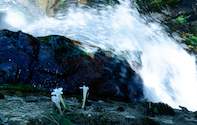
Finding water to create new energy requires an investment of old energy, researchers say. "No matter what kind of energy you want to create, from biofuels to nuclear to fossil fuel extraction and processing, you need water." It's a classic case of the chicken and the egg, but researchers believe solving it will trigger a revolution in sustainable energy.
"To get energy, you need water, and to get water where you want it, you need energy," says John Gasper, strategic area manager of the environmental assessment division at the U.S. Department of Energy's (DOE) Argonne National Laboratory. "There are opportunities within both cycles for basic science and the development of new technology to improve efficiency and bring us closer to energy independence."
Gasper coordinates Argonne's work on an environmental and economic concept known as the Energy-Water Nexus (EWN). Finding water to create new energy paradoxically requires an investment of old energy. Three percent of energy nationwide is used for the transportation and conditioning of water. In some arid parts of the US, like California, it's significantly more.
Researchers focus on discovering and processing previously unusable sources of water—one with the most potential can be found deep underground in oil and coal mines. While mines don't seem like the most likely source of water, they may significantly help to reduce the demand for freshwater from heavily taxed rivers and reservoirs.
"If you are a company that needs water, and you can't get it out of a river or out of a well, you are going to have to get creative to find new ways to get it," says John Veil, manager of Argonne's Water Policy Program. "If you have to move water or clean the water, the cost goes up." Over time, groundwater can seep into the mine, where it becomes contaminated with the natural metals and other poisonous compounds.
Underground hard coal mines—especially those in anthracite-rich regions like central Pennsylvania—often contain huge cavities that can get easily filled up with groundwater. Sometimes the water is fairly clean and can be easily filtered for impurities, but often the water is so contaminated that it can create significant environmental hazards.
Argonne, in conjunction with DOE's National Energy Technology Laboratory, has spent much of the past three years trying to find ways to recycle contaminated or polluted water for several different uses—most notably the cooling of power plants.
"We hope that this water stays in the mines as part of the natural groundwater," Veil says, "but sometimes so much of it accumulates that it overflows into the surface water streams, polluting them with acid and iron. We've been working on finding a way to put that water to good use while simultaneously relieving the burden on the environment."
In the initial study, Veil found six power plants located in Pennsylvania coal country that had either already introduced impaired water as a cooling source or had the potential to benefit from doing so. In the most interesting case, a large nuclear plant near Philadelphia had been taking immense quantities of water from the Schuylkill River for cooling.
At times of drought, the river stood so low that there was not enough water available to cool the plant, so its operators had to obtain it through a complicated and expensive transfer process. Desperate to bring down costs, the power company "did some homework," according to Veil.
"The power company identified an upstream coal mine that was special because it that it had a lot of water that was clean enough that it didn't need treatment before it could be discharged into the environment," he explains.
"So the power and mining companies agreed to withdraw a certain amount of water from the mine, place it in the river, and use it to supplement the river flow, essentially using nature as the transfer mechanism."
Argonne's quest to quench the thirst of other water-needy energy suppliers may not involve ultramodern technology or avant-garde experimental techniques, but Veil predicts the results will be truly transformative.
"The work we're doing is going to encourage power companies and other energy sources that require water to look more closely at water supplies that they might not have considered previously," Veil says. "When there aren't any more supplies of fresh water, we're generating new methods and new opportunities that will bring us closer to a fully sustainable energy future."

 Six major rivers, stretch across the wilderness of Kruger National Park, the Crocodile River, the Limpopo River and the Olifants, Sabie, Let...
Six major rivers, stretch across the wilderness of Kruger National Park, the Crocodile River, the Limpopo River and the Olifants, Sabie, Let...